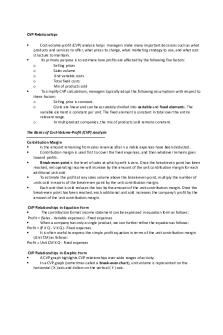05-Relevant Costing & CVP PDF

| Title | 05-Relevant Costing & CVP |
|---|---|
| Author | buls eye |
| Course | acca f5 notes |
| Institution | Association of Chartered Certified Accountants |
| Pages | 21 |
| File Size | 792.3 KB |
| File Type | |
| Total Downloads | 70 |
| Total Views | 187 |
Summary
Download 05-Relevant Costing & CVP PDF
Description
Decision-making Techniques Relevant Cost Analysis Concept of Relevant Costing Any short term decisions should be approached using relevant costing principles Companies and government bodies have increasingly tended to concentrate on their core competences – what they are really good at – and turn other functions over to specialist contractors. This is known as outsourcing or sub-contracting. Relevant costs and revenues are:
In the FUTURE CASH only INCREMENTAL only Decision making should be based on relevant costs and revenues.
1. Relevant costs are FUTURE costs. A decision is about the future and it cannot alter what has been done already. Costs that have been incurred in the past are totally irrelevant to any decision that is being made 'now’. Such costs are called past costs or sunk costs and are irrelevant. 2. Relevant costs are CASHFLOWS. Only cash flow information is required. This means that costs or charges which do not reflect additional cash spending (such as depreciation and notional costs) should be ignored for the purpose of decision making. 3. Relevant costs are INCREMENTAL costs and it is the increase in costs and revenues that occurs as a direct result of a decision taken that is relevant. Common costs can be ignored for the purpose of decision making. 4. Relevant costs are AVOIDABLE costs These are costs which would not be incurred if the activity to which they relate did not exist. Therefore, they are relevant to a decision. Committed costs are future costs that cannot be avoided because of decisions that have already been made. These are non-relevant costs
Opportunity Costs Opportunity costs only arise when resources are scarce and have alternative uses. When an alternative course of action is given up, the financial benefits lost are known as opportunity costs. So they are the lost contribution from the best use of the alternative forgone.
Relevant cost of Materials If used & replaced regularly this is their current replacement cost But what if we have already have them in stock and won't use them regularly? Well then we can either sell them or use them on another project So, here the relevant cost of using them is the higher of: • Their current resale value • Their alternative use value So also if the materials have no resale value and no other possible use, then the relevant cost is nil
Material Qty needed for Qty currently in Original cost of Current Current contract inventory qty in inv purchase price resale price
A
400 kg
200 kg
$10/kg
$15/kg
$12/kg
B
200 kg
100 kg
$20/kg
$22/kg
$15/kg
Material A is used regularly in the business. Material B is no longer used and has no alternative use in the business. The relevant cost of material is: Material A – regularly used – replace 400 kg x $15 = $6000 Material B – 100 kgs in stock could have been sold if not used in the contract opportunity cost = 100 kg x $15 = $1500 The other 10 0kg have to be purchased at $22 100 kg x $22 = $2200 Therefore $1500+$2200 = $3700 Please note that the original cost is a sunk cost, therefore irrelevant.
Relevant cost of Labour The key question here is: Is there spare capacity? Different Scenarios...
Spare capacity So, additional work can be undertaken at no extra cost :) Relevant cost of labour is 0
Full capacity - so hire more workers Relevant cost is current pay rates
Full capacity - takes workers from another project So this project can't be finished - so we lose its contribution but we still have to pay the workers on our project Relevant cost is Lost contribution + labour cost
Illustration The Hi Life Co makes sofas. It has recently received a request from a customer to provide a oneoff order of sofas, in excess of normal budgeted production. The order would need to be completed within two weeks. The following cost estimate has already been prepared: $ Direct materials: Fabric
200 m2 at $17 per m2
3,400
Wood
50 m2 at $8.20 per m2
410
Skilled
200 hours at $16 per hour
3,200
Semi-skilled
300 hours at $12 per hour
3,600
Factory overheads
500 hours at $3 per hour
1,500
Direct labour:
Total production cost
12,110
General fixed overheads at 10% of total production cost
1,211
Total cost
13,321
A quotation now needs to be prepared on a relevant cost basis so that Hi Life Co can offer as competitive a price as possible for the order.
The fabric is regularly used by Hi Life Co. There are currently 300 m2 in inventory, which cost $17 per m2. The current purchase price of the fabric is $17.50 per m2. The wood is regularly used by Hi Life Co and usually costs $8.20 per m2. However, the company's current supplier's earliest delivery time for the wood is in three weeks' time. An alternative supplier could deliver immediately but they would charge $8.50 per m2. Hi Life Co already has 500 m2 in inventory but 480 m2 of this is needed to complete other existing orders in the next two weeks. The remaining 20 m2 is not going to be needed until four weeks' time. The skilled labour force is employed under permanent contracts of employment under which they must be paid for 40 hours per week's labour, even if their time is idle due to absence of orders. Their rate of pay is $16 per hour, although any overtime is paid at time and a half. In the next two weeks there is spare capacity of 150 labour hours.
There is no spare capacity for semi-skilled workers. They are currently paid $12 per hour or time and a half for overtime. However, a local agency can provide additional semi-skilled workers for $14 per hour.
a) What is the cost of the fabric and the wood which should be included in the quotation (to the nearest whole $)? b) What cost should be included in the quotation for skilled labour and semi-skilled labour (to the nearest $)? Solution a) Fabric is in regular use, so the replacement cost is the relevant cost (200m2 x $17.50) = $3,500. 30m2 of wood will have to be ordered in from the alternative supplier but the remaining 20m2 which is in inventory and not needed for other work can be used and then replaced by an order from the usual supplier (30m2 x $8.50) + (20m2 x $8.20) = $419. b) Skilled labour: There is no cost for the first 150 hours as there is spare capacity. The remaining 50 hours required will be paid at time and a half, which is $16 x 1.5 = $24. 50 hours’ x $24 = $1,200 Semi-skilled labour: There is no spare capacity so the company will either need to pay overtime or hire in additional staff. The cost of paying overtime would be $18 per hour so it would be cheaper to hire in the additional staff for $14 per hour 300 hours’ x $14 = $4,200
Cost Volume Profit Analysis CVP Analysis Break even? One of the most important decisions that needs to be made before any business even starts is ‘how much do we need to sell in order to break-even?’ By ‘break-even’ we mean simply covering all our costs without making a profit. This type of analysis is known as ‘cost-volume-profit analysis’ (CVP analysis).
CVP analysis looks primarily at the effects of differing levels of activity on the financial results of a business. The reason for the particular focus on sales volume is because, in the short-run, sales price, and the cost of materials and labour, are usually known with a degree of accuracy. Sales volume, however, is not usually so predictable and therefore, in the short-run, profitability often hinges upon it.
Break-Even Point and Margin of Safety Break-even point The break-even point is when total revenues and total costs are equal i.e. there is no profit but also no loss made. There are three methods for ascertaining this BEP: 1. The equation method Total revenue – total variable costs – total fixed costs = Profit Note: total fixed costs are used rather than unit fixed costs since unit fixed costs will vary depending on the level of output. Also, selling price and costs are assumed to remain constant per unit of output.
2. The contribution margin method The contribution margin (contribution per unit) = selling price per unit less the variable costs per unit. BEP in units = Fixed Costs / Contribution per unit 3. The graphical method With the graphical method, the total costs and total revenue lines are plotted on a graph; $ is shown on the y axis and units are shown on the x axis. The point where the total cost and revenue lines intersect is the break-even point. The amount of profit or loss at different output levels is represented by the distance between the total cost and total revenue lines.
The graph below shows a typical break-even chart. The gap between the fixed costs and the total costs line represents variable costs.
The Breakeven chart can be read as:
Alternatively, a contribution graph could be drawn. This is very similar to a break-even chart; the only difference being that instead of showing a fixed cost line, a variable cost line is shown instead. Hence, it is the difference between the variable cost line and the total cost line that represents fixed costs. The advantage of this is that it emphasises contribution as it is represented by the gap between the total revenue and the variable cost lines.
Margin of safety The margin of safety indicates by how much sales can decrease before a loss occurs, i.e. it is the excess of budgeted revenues over break-even revenues.
Single and Multi-Product Situations: Contribution to Sales Ratio Single product situations It is often useful in single product situations, and essential in multi-product situations, to ascertain how much each $ sold actually contributes towards the fixed costs. This calculation is known as the contribution to sales or C/S ratio.
The C/S ratio is invaluable in helping us to quickly calculate the break-even point in $ sales revenue: BEP (sales revenue) Fixed Costs -----------C/S ratio
In single product situations, C/S ratio is calculated as follows: Total contribution ---------------------Total sales revenue or Contribution per unit --------------------Selling price
In multi-product situations, a weighted average C/S ratio is calculated by using the formula: Total contribution ------------------Total sales revenue
This weighted average C/S ratio can then be used to find CVP information such as break-even point, margin of safety, required profit (section 9.4 below) etc. Breakeven Point (BEP) = Fixed Costs ------------Average C/S Ratio
Single and Multi-Product Situations: Target Profit or Revenue Different Situations Target Profit or Revenue How many units must be sold to earn a target profit or revenue of an $x amount? The sales volume necessary in order to achieve this profit can be ascertained using any of the three methods outlined above
The equation method Total revenue – total variable costs – total fixed costs = Target Profit/Revenue
The contribution margin method The contribution margin (contribution per unit) = BEP in units = Fixed Costs + Target Profit / Revenue -------------------------------------Contribution per unit
In a multi-product situation, Required Revenue = Fixed Costs + Target Profit / Revenue ------------------------------------Average C/S Ratio
The graphical method The answer can also be read from the graph. The gap between the total revenue and total cost line represents profit (after the break even point) or loss (before the break even point).
Illustration 2 ABC Ltd has provided us with the following information: Selling price per unit $100 Variable costs per unit $60 Fixed Costs $250,000 per annum
ABC Ltd. wants to achieve a target profit of $400,000. Calculate the number of units which the company should produce and sell next year in order to achieve the target level of profit. Equation Method tr - tvc - tfc
=
profit
100q - 60q - 250000
=
400000
40q
=
650000
q
=
16250 units
OR Contribution Margin Method BEP (units)
=
fc + tp ------cont/unit
=
250000 + 40000 -----------------40
=
16250 units
Break-Even Charts and Profit Volume Break-Even Charts The breakeven point is where the total revenues line and the total costs line intersect. The profit-volume graph focuses purely on showing a profit/ loss line and doesn’t separately show the cost and revenue lines.
In a multi-product environment, it is common to actually show two lines on the graph: one straight line, where a constant mix between the products is assumed; and one bow-shaped line, where it is assumed that the company sells its most profitable product first and then its next most profitable product, and so on. In order to draw the graph, it is therefore necessary to work out the C/S ratio of each product being sold before ranking the products in order of profitability.
It can be observed from the graph that, when the company sells its most profitable product first (x) it breaks even earlier than when it sells products in a constant mix. The break-even point is the point where each line cuts the x axis.
Limitations of CVP Analysis for Planning and Decision Making These are: 1. Cost-volume-profit analysis is invaluable in demonstrating the effect on an organisation that changes in volume (in particular), costs and selling prices, have on profit. However, its use is limited because it is based on the following assumptions: either a single product is being sold or, if there are multiple products, these are sold in a constant mix. We have considered this above and seen that if the constant mix assumption changes, so does the break-even point. 2. All other variables, apart from volume, remain constant, i.e. volume is the only factor that causes revenues and costs to change. In reality, this assumption may not hold true as, for example, economies of scale may be achieved as volumes increase. Similarly, if there is a change in sales mix, revenues will change. Furthermore, it is often found that if sales volumes are to increase, sales price must fall. 3. The total cost and total revenue functions are linear. This is only likely to hold true within a shortrun, restricted level of activity. 4. Costs can be divided into a component that is fixed and a component that is variable. In reality, some costs may be semi-fixed, such as telephone charges, whereby there may be a fixed monthly rental charge and a variable charge for calls made. 5. Fixed costs remain constant over the ‘relevant range’ – levels of activity in which the business has experience and can therefore perform a degree of accurate analysis. It will either have operated at those activity levels before or studied them carefully so that it can, for example, make accurate predictions of fixed costs in that range. 6. Profits are calculated on a variable cost basis or, if absorption costing is used, it is assumed that production volumes are equal to sales volumes.
Illustration Hughes plc has recently developed a personal music player and is now considering what price to charge for the new product. A market research company has produced the following forecasts of demand at three potential selling prices: selling price
$250
$350
$450
sales units per annum
10000
8000
6000
fixed costs per annum
$800000
$500000
$200000
Variable costs are forecast at $220 per unit at any activity level. Required: a) Calculate, for each potential selling price, the budgeted profit, the break-even point in units and the margin of safety ratio (i.e. the margin of safety expressed as a percentage). b) Using the graph paper provided, draw and label a break-even chart for a selling price of $350 for activity levels between 0 and 8,000 units. (a)
$
$
$
selling price
250
350
450
variable cost
220
220
220
-----
-----
-----
contribution per unit
30
130
230
total units
10000
8000
6000
total contribution
300000
1040000
1380000
fixed cost
800000
500000
200000
---------
---------
---------
(50000)
540000
1180000
profit
Breakeven point in units = Fixed costs/contribution per unit selling price ($)
250
350
450
contribution per unit (1)
30
130
230
fixed cost ($)(2)
800000
500000
200000
breakeven point (units) (2 / 1)
26667
3846
870
budgeted units
10000
8000
6000
margin of safety
nil
4154
5130
margin of safety ratio
nil
52%
86%
MOS = Budgeted Sales – Break-Even Sales Or Budgeted Sales – Break-Even Sales --------------------------------Budgeted Sales
b) Breakeven Chart
Illustration The following scenario relates to four requirements.
The Alka Hotel is situated in a major city close to many theatres and restaurants. The Alka Hotel has 25 double bedrooms and it charges guests $180 per room per night, regardless of single or double occupancy. The hotel’s variable cost is $60 per occupied room per night. The Alka Hotel is open for 365 days a year and has a 70% budgeted occupancy rate. Fixed costs are budgeted at $600,000 a year and accrue evenly throughout the year. During the first quarter (Q1) of the year the room occupancy rates are significantly below the levels expected at other times of the year with the Alka Hotel expecting to sell 900 occupied room nights during Q1. Options to improve profitability are being considered, including closing the hotel for the duration of Q1 or adopting one of two possible projects as follows: Project 1 - Theatre Package For Q1 only the Alka Hotel management would offer guests a 'Theatre Package'. Couples who pay for two consecutive nights at a special rate of $67.50 per room night will also receive a pair of theatre tickets for a payment of $100. The theatre tickets are very good value and are the result of long negotiation between the Alka Hotel management and the local theatre. The theatre tickets cost the Alka Hotel $95 a pair. The Alka Hotel's fixed costs specific to this project (marketing and administration) are budgeted at $20,000. The hotel’s management believe that the 'Theatre Package' will have no effect on their usual Q1 customers, who are all business travellers and who have no interest in theatre tickets, but will still require their usual rooms. Project 2 - Restaurant There is scope to extend the Alka Hotel and create enough space to operate a restaurant for the benefit of its guests. The annual costs, revenues and volumes for the combined restaurant and hotel are illustrated in the following graph:
Note: the graph does not include the effect of the 'Theatre Package' offer.
Required (a) Using the current annua...
Similar Free PDFs
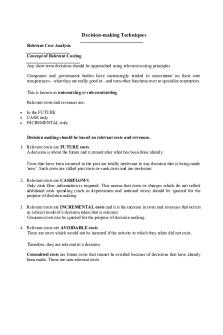
05-Relevant Costing & CVP
- 21 Pages
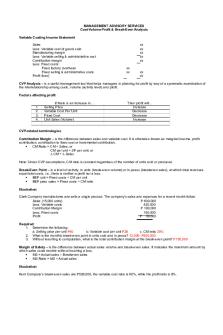
CVP Analysis - CVP
- 9 Pages
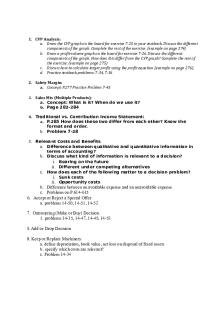
CVP - Chapter 6 on CVP
- 2 Pages

06 CVP Relationships
- 51 Pages

CVP Drill
- 4 Pages

MAS CVP Reviewer
- 26 Pages

COM 316 Chapter 7: CVP
- 10 Pages

Variable costing dan Full costing
- 28 Pages
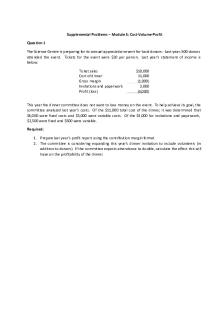
Supplemental Problems CVP up
- 5 Pages

Chapter 22 - CVP Analysis
- 52 Pages

CVP guide questions
- 20 Pages
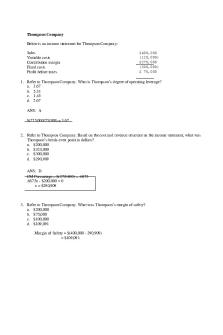
4.5 CVP3 - CVP 3 answers?
- 4 Pages

Additional Practices for CVP
- 11 Pages

CVP Excel exercise 1
- 2 Pages
Popular Institutions
- Tinajero National High School - Annex
- Politeknik Caltex Riau
- Yokohama City University
- SGT University
- University of Al-Qadisiyah
- Divine Word College of Vigan
- Techniek College Rotterdam
- Universidade de Santiago
- Universiti Teknologi MARA Cawangan Johor Kampus Pasir Gudang
- Poltekkes Kemenkes Yogyakarta
- Baguio City National High School
- Colegio san marcos
- preparatoria uno
- Centro de Bachillerato Tecnológico Industrial y de Servicios No. 107
- Dalian Maritime University
- Quang Trung Secondary School
- Colegio Tecnológico en Informática
- Corporación Regional de Educación Superior
- Grupo CEDVA
- Dar Al Uloom University
- Centro de Estudios Preuniversitarios de la Universidad Nacional de Ingeniería
- 上智大学
- Aakash International School, Nuna Majara
- San Felipe Neri Catholic School
- Kang Chiao International School - New Taipei City
- Misamis Occidental National High School
- Institución Educativa Escuela Normal Juan Ladrilleros
- Kolehiyo ng Pantukan
- Batanes State College
- Instituto Continental
- Sekolah Menengah Kejuruan Kesehatan Kaltara (Tarakan)
- Colegio de La Inmaculada Concepcion - Cebu

